Yes — anaerobic exercise can dramatically speed up your strength gains and fat loss. Anaerobic exercise refers to short, intense bursts of activity where your body relies on stored energy, not oxygen. Understanding anaerobic training is important because it helps you build muscle, boost power, and elevate your metabolism far more than steady-state cardio.
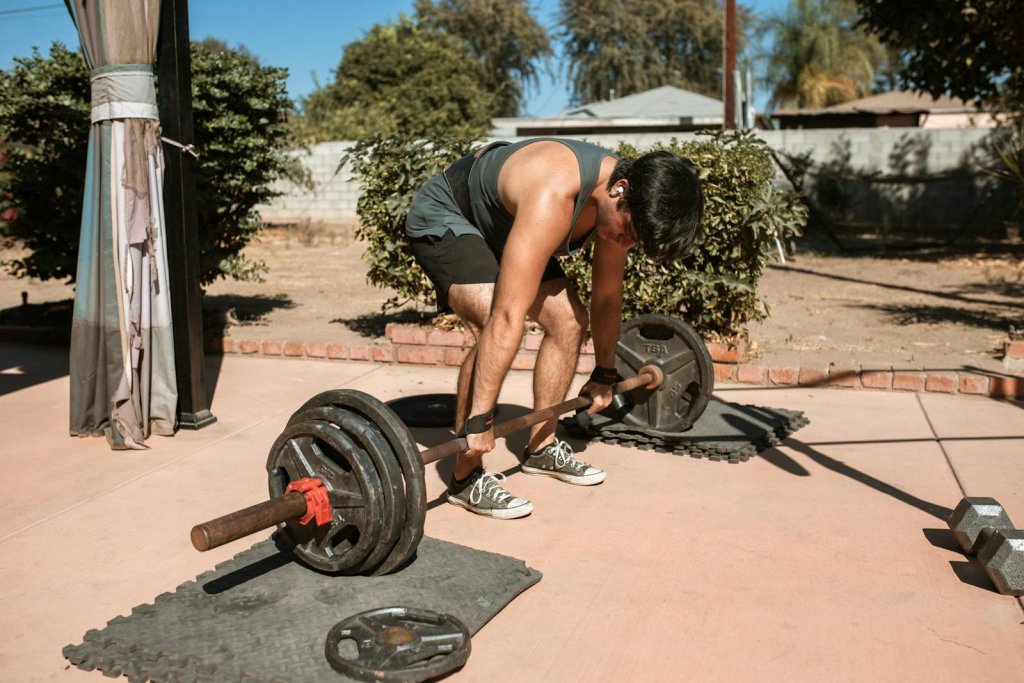
This guide breaks down the top 17 anaerobic exercise examples, how they work, and how to use them safely. You’ll also learn key benefits, safety tips, and FAQs.
What Is Anaerobic Exercise?
Anaerobic exercise involves high-intensity activities performed for a short duration, usually lasting 10 seconds to 2 minutes. These efforts are too intense for your body to supply energy through oxygen, so it taps into stored ATP and glycogen.
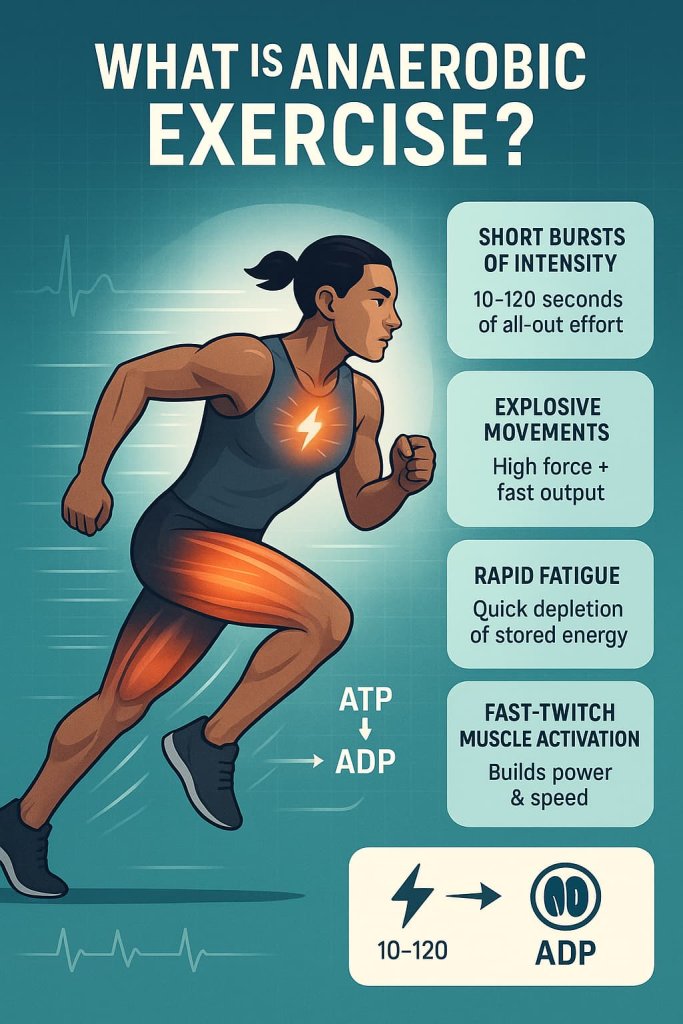
Core characteristics of anaerobic training include:
- Short bursts of very high intensity
- Heavy resistance or explosive movement
- Rapid fatigue
- Higher demand on fast-twitch muscle fibers
Anaerobic work is the foundation for building strength, speed, and power while boosting overall metabolic output.
Benefits of Anaerobic Exercise for Strength & Fat Loss
Anaerobic training:
- Supports muscle and strength development
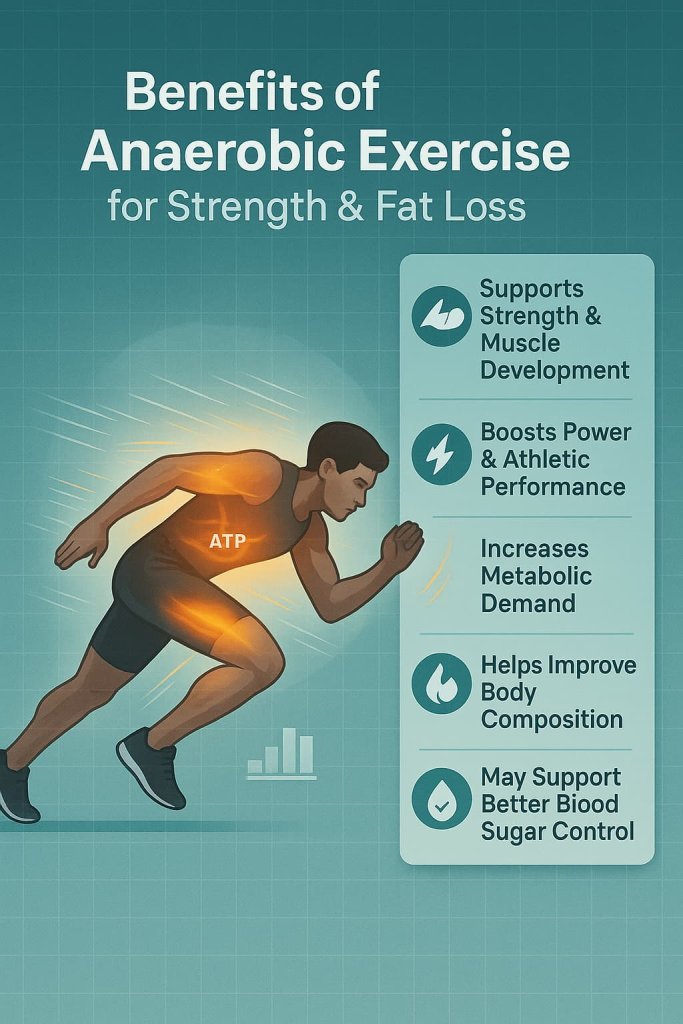
- Boosts power and athletic performance
- Raises metabolic demand to support fat loss
- Helps improve body composition
- May support better blood sugar control
This section is informational only and not medical advice.
How to Warm Up Before Anaerobic Training
A warm-up prepares your muscles and joints for explosive effort.
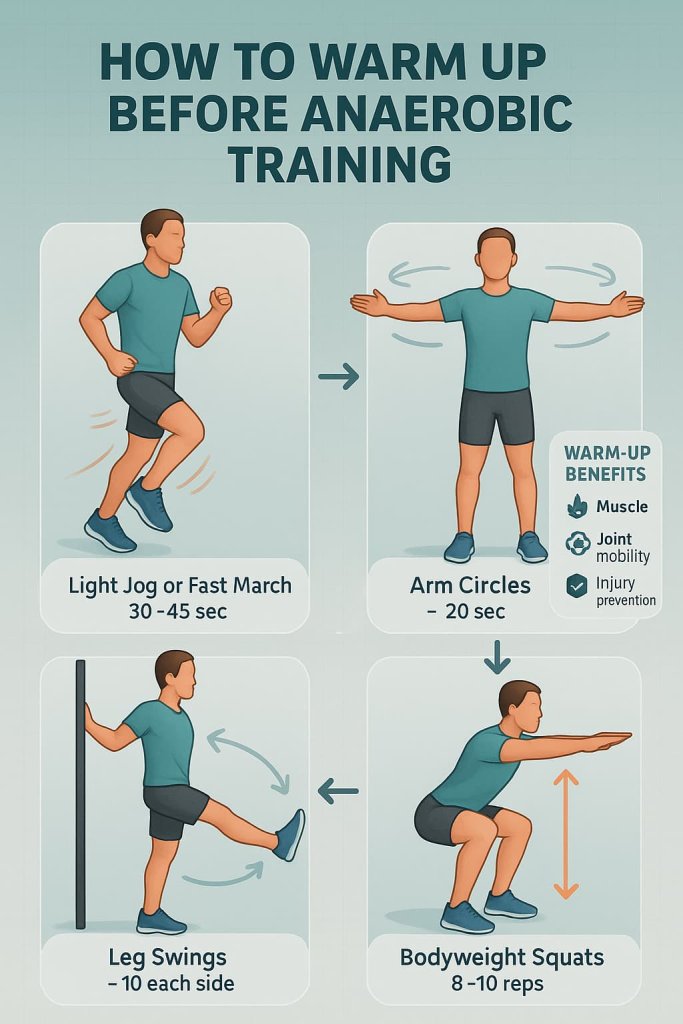
Quick 3–5 Minute Warm-Up:
- Light jogging or fast marching
- Arm circles (20 seconds)
- Leg swings (10 each)
- Bodyweight squats (8–10 reps)
Always warm up before sprints, jumps, or heavy lifting.
17 Best Anaerobic Exercise Examples
Below are the 17 most effective anaerobic exercises, organized into categories for easy navigation.
Sprint-Based Anaerobic Exercises
1. Running Sprints
Why it works:
Running sprints rely heavily on the ATP-PC energy system, forcing fast-twitch muscle fibers to fire at maximum speed. This boosts power, explosiveness, leg strength, and fat-burning intensity in a short timeframe.
Muscles worked:
Quadriceps, hamstrings, glutes, calves, hip flexors, core.
How to do it:
- Warm up for 3–5 minutes.
- Accelerate into a full-speed sprint for 10–30 seconds.
- Walk or stand still for 60–90 seconds to recover fully.
- Repeat for 4–8 rounds.
Trainer Tip:
Avoid starting from a dead stop—build up speed over a few strides to protect your hamstrings.
2. Hill Sprints
Why it works:
The incline adds natural resistance, increasing force production and reducing joint impact. Hills make your posterior chain work harder, improving power and speed rapidly.
Muscles worked:
Glutes, hamstrings, quadriceps, calves, core.
How to do it:
- Choose a moderate incline hill.
- Sprint uphill for 10–20 seconds.
- Walk back down for recovery.
- Perform 4–6 rounds.
Trainer Tip:
Leaning slightly forward helps maintain momentum and reduces over-striding.
3. Stair or Stadium Sprints
Why it works:
Stairs demand high knee drive, increased lower-body strength, and rapid anaerobic output. They build explosive leg power and cardiovascular capacity.
Muscles worked:
Quadriceps, glutes, hamstrings, calves, hip flexors.
How to do it:
- Find a staircase or stadium steps.
- Sprint upward at a fast but controlled pace.
- Walk back down carefully for recovery.
- Complete 4–10 rounds depending on fitness level.
Trainer Tip:
Focus on driving your knees up and using short, powerful steps instead of bounding.
4. Cycling Sprints
Why it works:
Cycling sprints provide a low-impact way to hit maximum anaerobic effort. The resistance and cadence create powerful leg drive and high metabolic demand.
Muscles worked:
Quads, glutes, hamstrings, calves, hip flexors, core.
How to do it:
- Set the bike resistance to medium-high.
- Sprint at maximum effort for 20–30 seconds.
- Pedal slowly for 60–90 seconds to recover.
- Repeat 6–10 rounds.
Trainer Tip:
Push through the heels, not the toes, to increase glute activation and power.
Strength-Focused Anaerobic Exercises
5. Heavy Back Squats
Why it works:
Heavy squats engage multiple large muscles and require high anaerobic output. Low-rep squats improve maximal strength, hormone response, and metabolic demand.
Muscles worked:
Quadriceps, glutes, hamstrings, calves, core, spinal erectors.
How to do it:
- Place barbell securely on your upper back.
- Squat down with controlled form.
- Perform 3–5 reps using heavy weight.
- Rest 2–4 minutes between sets.
- Complete 3–5 sets.
Trainer Tip:
Brace your core before descending to protect the spine and increase power.
6. Deadlifts
Why it works:
Deadlifts activate the largest muscles in the body, forcing a strong anaerobic response. The lift increases strength, power, and total muscle recruitment.
Muscles worked:
Hamstrings, glutes, lower back, traps, forearms, core.
How to do it:
- Set feet hip-width apart.
- Hinge at hips and grip the bar.
- Drive through heels to stand tall.
- Perform 3–5 heavy reps, resting 2–3 minutes.
- Do 3–5 sets.
Trainer Tip:
Drive your feet into the floor—don’t yank the bar—to maintain strong positioning.
7. Bench Press
Why it works:
The bench press recruits large upper-body muscles in a powerful, short burst. Heavy low-rep pressing strengthens chest, triceps, and shoulder power.
Muscles worked:
Pectorals, triceps, front deltoids, core stabilizers.
How to do it:
- Position feet firmly on the ground.
- Lower the bar with control.
- Press hard for 3–5 reps per set.
- Rest 2–3 minutes.
- Perform 3–5 sets.
Trainer Tip:
Squeeze your shoulder blades together to increase pressing stability and power.
8. Olympic Lifts (Clean, Snatch, Power Clean)
Why it works:
Olympic lifts use explosive, full-body movements that require high power output and fast-twitch fiber recruitment. Ideal for athletes and rapid strength development.
Muscles worked:
Glutes, quads, hamstrings, traps, shoulders, core, upper back.
How to do it:
- Start with a light-to-moderate barbell.
- Explosively pull from the floor.
- Catch the bar in a strong, stable position.
- Perform 1–3 explosive reps per set.
- Rest 2–3 minutes.
Trainer Tip:
Master technique with light weight before moving heavy—speed matters more than load.
Plyometrics & Explosive Bodyweight Movements
9. Jump Squats
Why it works:
Jump squats build explosive lower-body power and elevate heart rate quickly, making them perfect for anaerobic conditioning.
Muscles worked:
Glutes, quads, hamstrings, calves, core.
How to do it:
- Squat down with hips back.
- Explode upward into a jump.
- Land softly and reset.
- Perform 6–10 reps.
- Rest 45–60 seconds.
Trainer Tip:
Focus on soft landings to protect knees and improve force absorption.
10. Box Jumps
Why it works:
Box jumps develop vertical power, fast-twitch response, and lower-body explosiveness while reducing impact compared to ground jumps.
Muscles worked:
Quads, glutes, hamstrings, calves, core.
How to do it:
- Stand in front of a stable box.
- Bend knees and swing arms.
- Explosively jump onto the box.
- Step down gently.
- Perform 5–8 reps.
Trainer Tip:
Choose a box height you can jump onto without excessive knee tuck or fear.
11. Burpee Sprints
Why it works:
Burpee sprints combine explosive movement with rapid transitions, maximizing anaerobic output and calorie burn.
Muscles worked:
Chest, shoulders, triceps, quads, glutes, hamstrings, core.
How to do it:
- Drop into a plank.
- Perform a push-up (optional).
- Jump feet under hips.
- Explode upward into a jump.
- Perform as many reps as possible in 20–30 seconds.
Trainer Tip:
Keep your core tight during the plank to avoid lower-back sag.
12. Plyometric Push-Ups
Why it works:
Explosive push-ups challenge upper-body power, speed, and anaerobic strength.
Muscles worked:
Chest, triceps, shoulders, serratus anterior, core.
How to do it:
- Lower chest to the ground.
- Push explosively so hands leave the floor.
- Land with soft elbows.
- Perform 5–10 reps.
- Rest 60–90 seconds.
Trainer Tip:
Start with knee-assisted plyometric push-ups if full versions are too difficult.
Anaerobic Conditioning & Power Tools
13. Kettlebell Swings (Heavy)
Why it works:
The hip hinge movement produces high force quickly, making heavy swings ideal for anaerobic conditioning and metabolic power.
Muscles worked:
Glutes, hamstrings, core, lower back, shoulders, grip muscles.
How to do it:
- Hinge at the hips with a flat back.
- Drive the kettlebell forward with hip power.
- Swing to chest height.
- Perform 15–20 powerful swings.
- Rest 60–90 seconds.
Trainer Tip:
Avoid squatting—use a pure hip hinge to maximize power and safety.
14. Battle Rope Slams
Why it works:
Battle rope slams demand high upper-body and core output, creating short, intense bursts perfect for anaerobic training.
Muscles worked:
Shoulders, biceps, triceps, forearms, core, upper back, glutes.
How to do it:
- Stand with feet shoulder-width apart.
- Raise ropes overhead.
- Slam them down as hard as possible for 15–30 seconds.
- Rest 60–90 seconds.
Trainer Tip:
Use your hips—not just your arms—to increase power output.
15. Medicine Ball Slams
Why it works:
Medicine ball slams build explosive core strength and train fast-twitch muscle fibers through full-body force production.
Muscles worked:
Core, shoulders, lats, glutes, quads.
How to do it:
- Lift the ball overhead.
- Forcefully slam it into the ground.
- Pick it up quickly and repeat.
- Perform 8–12 explosive reps.
Trainer Tip:
Use a non-bouncing ball to maintain safe, controlled reps.
16. Sled Pushes / Sled Drags
Why it works:
The sled offers heavy resistance without eccentric loading, allowing high-intensity anaerobic work with lower injury risk.
Muscles worked:
Quads, glutes, hamstrings, calves, core, upper back.
How to do it:
- Load sled with moderate to heavy weight.
- Push or drag it for 10–20 meters.
- Rest 60–90 seconds.
- Repeat for 4–8 rounds.
Trainer Tip:
Keep your torso leaning forward with strong, driving steps to maximize force.
17. High-Intensity Interval Training (HIIT)
Why it works:
Short max-effort intervals strategically paired with rest periods spike metabolism, improve anaerobic capacity, and support fat loss.
Muscles worked:
Varies by movement (common: quads, glutes, chest, shoulders, core).
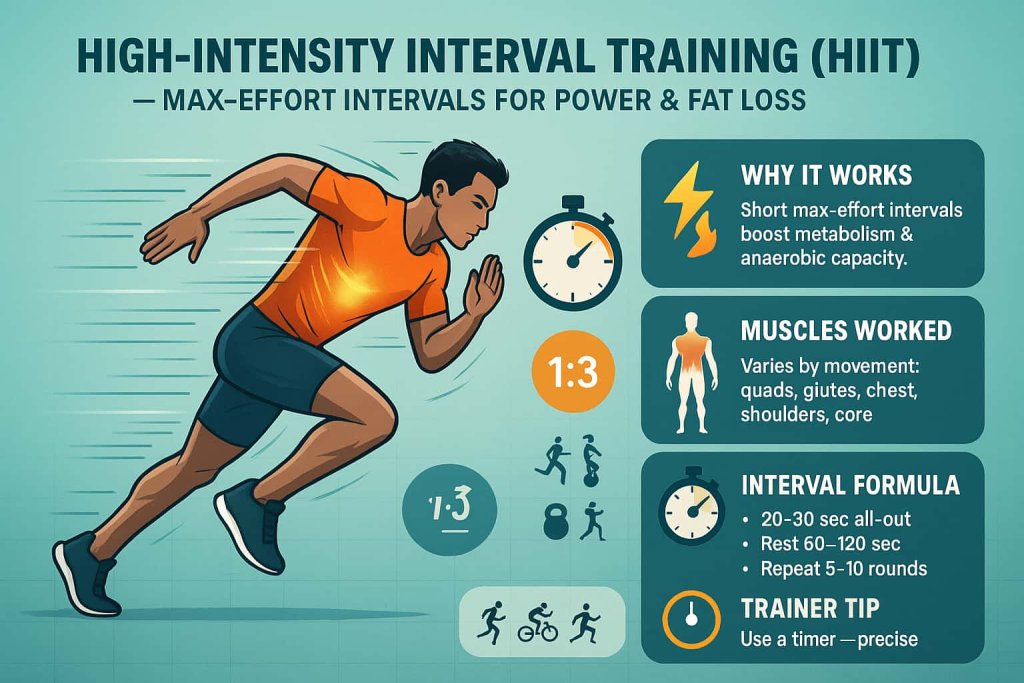
How to do it:
- Choose an exercise (sprints, bike, burpees, etc.).
- Perform 20–30 seconds all-out.
- Rest 60–120 seconds.
- Repeat for 5–10 rounds.
Trainer Tip:
Use a timer—precision is crucial for true HIIT intensity.
How to Structure an Anaerobic Workout
Warm-Up (5–8 minutes)
- Light jogging or marching
- Dynamic stretches
- Mobility for hips, shoulders, and spine
Main Anaerobic Training
Choose 2–4 exercises, such as:
- Sprints: 20 seconds on, 60–90 seconds rest
- Heavy lifts: 3–5 reps per set
- Plyometrics: 6–10 reps
Rest
Anaerobic training requires full recovery:
- 1–4 minutes depending on intensity
Frequency
Do 2–3 anaerobic sessions per week, with recovery or moderate aerobic work on off days.
Safety Tips for Anaerobic Work
- Start with manageable intensity, especially if new to high-intensity workouts.
- Warm up thoroughly to reduce injury risk.
- Maintain proper technique, especially during heavy or explosive movements.
- Allow adequate recovery between sessions.
- People with medical conditions should consult a healthcare professional before beginning very intense exercise.
Who Should Be Careful (Safety Guidelines)
Anaerobic exercise is intense, so certain individuals should be cautious:
- Beginners or deconditioned individuals
- Anyone with heart or blood pressure concerns
- People with joint pain or injuries
- Those who feel dizzy or faint during exertion
Start slowly, warm up well, and check with a healthcare provider if you have health concerns.
FAQs
1. Is anaerobic exercise better than aerobic exercise?
No — both have unique benefits. Anaerobic builds strength and power, while aerobic supports endurance and heart health.
2. How long should anaerobic intervals last?
Usually 10 seconds to 2 minutes, depending on the movement.
3. How often should I do anaerobic training?
2–3 times per week is ideal for most people.
4. Can beginners do anaerobic training?
Yes — start with lower intensity, longer rest, and basic movements.
5. Does anaerobic exercise burn fat?
Yes — high-intensity training increases metabolic demand and supports fat loss when combined with consistent rest and proper nutrition.
6. Do I still need aerobic exercise?
Yes — combining both methods gives the best results for health, endurance, and recovery.
7. What’s the best anaerobic exercise for fat loss?
Sprints, heavy kettlebell swings, battle ropes, and short HIIT intervals are highly effective.
Conclusion
Anaerobic exercise is one of the fastest ways to build strength, power, and a leaner body. By choosing a few exercises from this list of 17 powerful examples, you can create a training routine that delivers real results. Start with simple movements, progress gradually, and stay consistent.
Choose 3 exercises from the list above and build your first anaerobic session for this week. Track your performance, recover well, and expect steady, measurable improvements.
References
- Garber CE et al. (2011). Quantity and Quality of Exercise for Developing and Maintaining Cardiorespiratory, Musculoskeletal, and Neuromotor Fitness in Apparently Healthy Adults. Medicine & Science in Sports & Exercise.
https://pubmed.ncbi.nlm.nih.gov/21694556/ - Ratamess NA et al. (2009). American College of Sports Medicine Position Stand: Progression Models in Resistance Training for Healthy Adults. Medicine & Science in Sports & Exercise.
https://pubmed.ncbi.nlm.nih.gov/19204579/ - Khodadadi F et al. (2023). The Effect of High-Intensity Interval Training Type on Body Composition in Adults: A Systematic Review and Meta-Analysis. Journal of Clinical Medicine.
https://www.mdpi.com/2077-0383/12/6/2291 - Yue F et al. (2025). Effects of High-Intensity Interval Training on Aerobic and Anaerobic Performance in Olympic Combat Athletes. Frontiers in Physiology.
https://www.frontiersin.org/articles/10.3389/fphys.2025.1576676/full - Vollaard NBJ et al. (2017). Research into the Health Benefits of Sprint Interval Training. Sports Medicine.
https://pmc.ncbi.nlm.nih.gov/articles/PMC5684281/ - Yin H et al. (2025). Effectiveness of High-Intensity Interval Training on Body Composition and Physical Fitness in University Students: A Systematic Review and Meta-Analysis. BMC Public Health.
https://bmcpublichealth.biomedcentral.com/articles/10.1186/s12889-025-22829-7 - Aerobic vs Anaerobic Exercise on Body Composition and Hormonal Adaptations in Athletes and Non-Athletes: A Randomized Controlled Trial. Journal of Clinical and Sport Sciences (2025).
https://journal.foundae.com/index.php/jcss/article/download/553/272 - Paluch AE et al. (2024). Resistance Exercise Training in Individuals With and Without Cardiovascular Disease: Benefits and Considerations. Circulation.
https://www.ahajournals.org/doi/10.1161/CIR.0000000000001189
